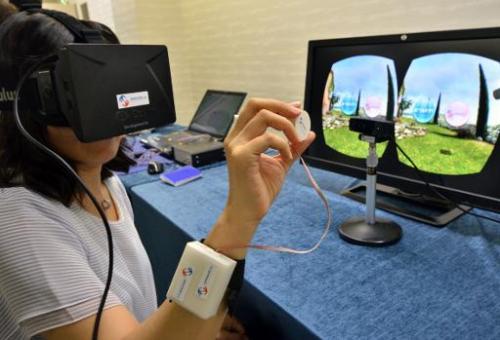Japanese high-tech firm, Miraisens, announced that it has developed haptic technology, which closes the tactility gap that formerly existed with the virtual reality experience. Haptic technology or “haptics” simulates the sense of touch by applying vibrations, forces, or motions to the user. The company, based in Tsukuba, just outside of Tokyo, says its haptic technology “will give you a sense that you can touch objects in the 3D world.”
Japan’s high-tech venture Miraisens CEO Natsuo Koda demonstrates “3D-Haptics Technology” at a press preview.
More familiar applications for haptic technology are, for example, the video game controllers that simulate the tactile experience of automobile driving–from racing to high-speed chases. Game controllers, including steering wheels, rumble or vibrate in response to, for instance, the texture of the road surface, the speed of the vehicle. and certain driving maneuvers such as sharp turns. Miraisens’ haptic technology renders earlier efforts like these somewhat quaint. “It works by fooling the brain,” says Norio Nakamura, chief technical officer at Miraisens, and the inventer of 3D-Haptics Technology, “blending the images the eye is seeing with different patterns of vibration created by a small device on the fingertip.”
At the press conference in Tsukuba, a journalist was allowed to demonstrate a prototype head-mount display, which connects with a small hand-held, coin-shaped device that enables the user to feel resistance from virtual buttons he or she pushes. The company says the haptics system can be built into devices in the shape of pens, sticks, or coins, like the one demonstrated. In fact, as a company spokesperson suggested, one particularly invaluable use for the new technology a navigation assistance system in the form of a cane for visually impaired people.
Miraisens, which is a spin-off of the National Institute of Advanced Industrial Science and Technology, anticipates many uses for the technology, including opening remarkable new 3D horizons in video gaming: “It could be used to give a sense of resistance in response to certain actions within the game,” they speculated. Other likely uses will be medicine or a combination of medicine and robotics, particularly with remote surgery. In such scenarios, an expert surgeon might perform surgery on a patient from a thousand miles away. Nursing staff would set up the equipment, prep and monitor the patient. The surgeon would be a telepresence, receiving resistance and tactile feedback during the procedure.
The company provided other examples where their haptics system could be applied and this is where 3D printing comes into play: “It could also be used,” they suggest, “to make up complicated data that could be fed into a 3D printer, allowing a child to make a virtual dinosaur model and then watch it come into existence.” And that’s evidently the next step for Miraisens, as the company aims to create commercial applications for this groundbreaking technology in the electronics and service industries.
What do you think would be the best uses for this technology within the 3D printing and modeling space? Discuss in the Touchable 3D Technology forum thread on 3DPB.com
